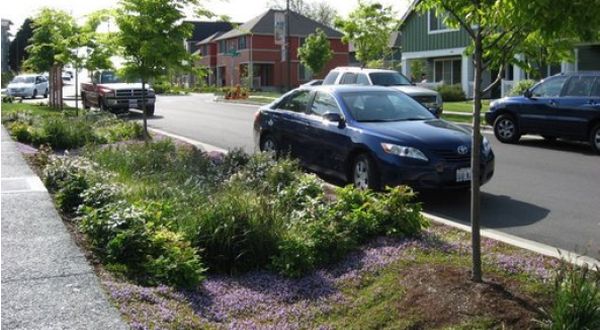What's This Funder Up to at the Nexus of Poverty, Pollution, and Parks?
/
Green infrastructure is an increasingly popular tactic that sits at the confluence of city parks, water, and poverty. It’s also a prime topic for philanthropy, and one funder is backing a national project to advance the work in low-income communities.
The JPB Foundation, a sizable funder, gave $2.5 million to a new project called the Great Urban Parks Campaign, which will create educational resources and fund pilot projects for green infrastructure in low-income communities. This strategy of managing water using green spaces is a hot topic that merges several philanthropic interests while addressing a common problem in many U.S. cities.
Related: For Green Giving, 2015 Was the Year of the City
Most older American cities rely heavily on channeling away urban stormwater through aging systems of drains and pipes (so-called “grey infrastructure”), sweeping up all kinds of trash and oily pollution along with it. Aside from being gross, it leads to flooding, sewer overflows, and city pollution making its way into nearby bodies of water.
One solution is green infrastructure, which sounds super-boring but is actually super-cool, as it uses city features to grab that water and steadily filter it back into the ground on the spot.
That alone would make it a draw for plenty of pollution-hating environmental funders eager to throw down some porous pavement and green patches. But what’s really interesting about the practice, and what makes it such a powerful tool for philanthropy, is that building green infrastructure has potential spinoff benefits in the areas of health and poverty, as well as city improvement.
Reduce reliance on systems of sewer pipes, and you can not only reduce the nasty flooding that disproportionately impacts low-income communities, but also create much-needed green spaces for city dwellers, increase outdoor recreation, and even create jobs.
Related: For Surdna, Infrastructure is Where Justice and Sustainability Cross Paths
This particular program is run by the American Planning Association and the National Recreation and Park Association, and kicked off in March with a conference in Atlanta. It’s spreading best practices for cities, and will also be awarding grants up to $575,000 for local projects.
This kind of work is frequently funded by local foundations and companies, as it’s a relatively affordable, enhances city pride, and offers some nice visuals, too. But in the case of the Great Urban Parks Campaign, you’ve got the involvement of a national funder with interests in both the environment and poverty.
A bit about JPB: The foundation's wealth is from Jeffry and Barbara Picower, and if the name sounds familiar, it’s because the late Jeffry was the biggest beneficiary of the Bernie Madoff Ponzi scheme. They were tied up in litigation when Jeffry Picower died in 2009, and in 2010, Barbara Picower returned $7.2 billion, while maintaining that her husband was unaware of any fraud.
The full backstory is pretty crazy, but what emerged is a new foundation with more than $3 billion in assets run by Barbara Picower. JPB has a growing profile in a number of areas. Notable grantmaking includes $25 million to MIT, and more than $15 million combined to the Center for Community Change, a social movement nonprofit for low-income communities. Funny how these things work out.
Anyway, you can see how green infrastructure has appeal beyond water funders, although one of the big emerging players in green infrastructure is California-based water funder Pisces Foundation.
Combine the different angles, the visibility, the nice bang for the buck of these projects, and the fact that urban systems are aging fast, and that means we’re likely only seeing the beginning of green infrastructure funding.
Related: One Funder That Wants to Improve How U.S. Cities Manage Water








